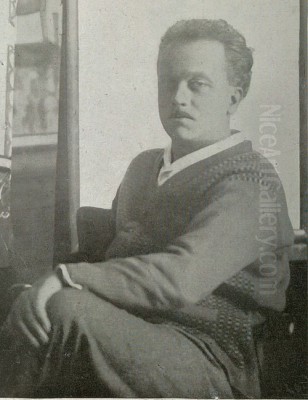
Raoul Dufy stands as one of the most distinctive and joyous figures in early 20th-century French art. Born in Le Havre, France, on June 3, 1877, and passing away in Forcalquier on March 23, 1953, Dufy's career spanned a transformative period in modern art. He is celebrated for his vibrant, optimistic paintings, characterized by a unique handling of color and line, often depicting scenes of leisure, society, and the beauty of the natural world. Though initially associated with Impressionism and later a key participant in Fauvism, Dufy forged a highly personal style that also absorbed elements of Cubism and remained dedicated to decorative harmony and visual pleasure. His prolific output extended beyond painting to encompass influential work in textile design, ceramics, illustration, and large-scale public murals.
Early Life and Artistic Formation in Le Havre and Paris
Raoul Dufy's journey into art began in the bustling port city of Le Havre in Normandy. Born into a large family, his early life was marked by a need to contribute financially. At 18, in 1895, he left school to work for a coffee importing company. However, his passion for art led him to attend evening classes at Le Havre's municipal art school. It was here that he began to develop his skills, initially drawing inspiration from the Normandy landscapes and the maritime activity surrounding him. A fellow student and lifelong friend from this period was Othon Friesz, who would also become a notable Fauvist painter.
Dufy's early artistic leanings were towards Impressionism. He admired the works of masters like Claude Monet and Camille Pissarro, captivated by their approach to light and atmospheric effects. His early paintings, such as Market Day in Falaise (1902), reflect this influence, showing an interest in capturing fleeting moments of everyday life with a relatively traditional application of paint, though already hinting at a bright palette. A municipal scholarship awarded in 1896 proved pivotal, enabling him to move to Paris and enroll at the prestigious École Nationale Supérieure des Beaux-Arts. There, he studied under the academic painter Léon Bonnat, but found himself increasingly drawn to the more radical artistic currents emerging in the capital.
The Fauvist Revelation and Embrace of Pure Color
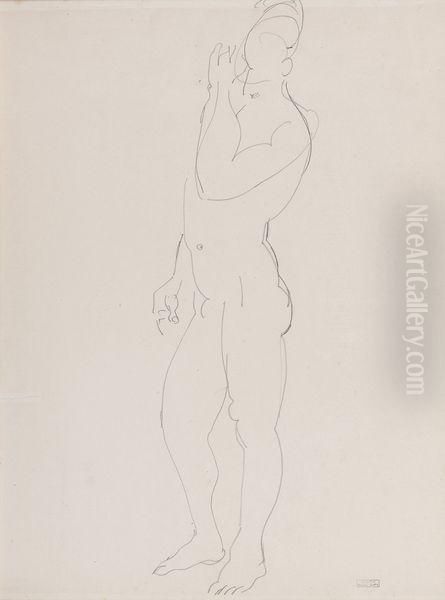
The year 1905 marked a significant turning point in Dufy's artistic development. While visiting the Salon des Indépendants, he encountered Henri Matisse's groundbreaking painting, Luxe, Calme et Volupté. Dufy was profoundly struck by the work's bold use of non-naturalistic color and its expressive freedom. He later described it as a revelation, realizing the new emotional potential of color divorced from strict representation. This encounter propelled him firmly into the orbit of Fauvism, the movement characterized by its intense palettes and vigorous brushwork, spearheaded by artists like Matisse, André Derain, and Maurice de Vlaminck.
Dufy began exhibiting with the Fauves, participating in the famous 1905 Salon d'Automne (though his major impact came slightly later) and subsequent group shows. He adopted the Fauvist ethos, employing brilliant hues – vibrant blues, reds, yellows, and greens – applied often in flat planes or energetic strokes. His subjects remained rooted in observation – street scenes, beaches, flags waving – but were now transformed by this heightened chromatic intensity. Works from this period show a clear departure from Impressionism towards a more subjective and emotionally charged use of color. He formed connections with other artists associated with the movement, including Albert Marquet, Georges Braque (during his Fauve phase), and Kees van Dongen, sharing in the collective exploration of color's expressive power.
Exploring Structure: Cézanne, Cubism, and the Stenographic Style
While Fauvism liberated Dufy's use of color, he soon felt the need for greater structure in his compositions. Around 1908, like many artists of his generation, he turned his attention to the work of Paul Cézanne. Cézanne's emphasis on underlying geometric forms and his method of constructing space through color planes offered a compelling alternative to the purely emotive expression of Fauvism. Dufy began to experiment with simplifying forms and incorporating more defined structures into his paintings, briefly engaging with the principles that were concurrently leading Georges Braque and Pablo Picasso towards the development of Cubism.
Dufy spent time working alongside Braque in L'Estaque, a location famously painted by Cézanne, absorbing these new ideas. However, Dufy's engagement with Cubism was relatively short-lived and highly personalized. He did not adopt the monochromatic palette or the complex faceting of Analytical Cubism. Instead, he integrated Cézanne's lessons on structure in a way that complemented his existing interest in line and color. This period led to the development of what has been termed his "stenographic" style – characterized by angular, simplified forms and rapid, calligraphic lines that define objects and figures, often independent of the color areas they contain. This approach allowed him to maintain clarity and dynamism while exploring a more structured compositional framework.
A Unique Visual Language: The Mature Dufy Style
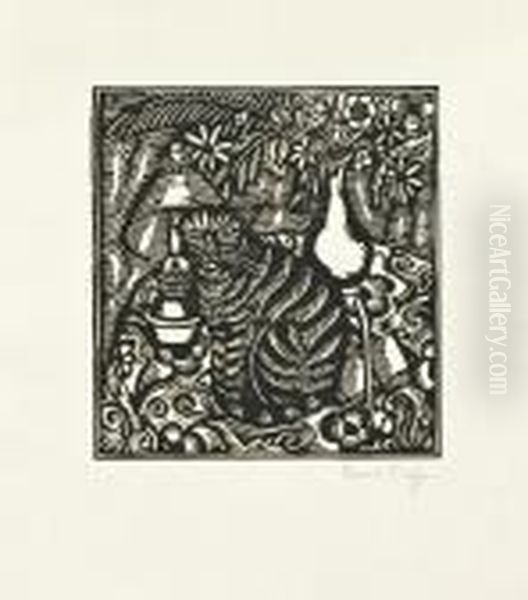
By the 1920s, Raoul Dufy had synthesized his experiences with Impressionism, Fauvism, and Cubism into a mature and instantly recognizable style. This signature approach is perhaps best known for its characteristic separation of drawing and color. Dufy would often lay down broad, luminous washes of watercolor or thin oil paint, creating zones of vibrant hue. Over this, he would superimpose a quick, fluid, and remarkably descriptive line, usually in black or a dark color, sketching out the forms of figures, buildings, or landscape elements. This line often floats freely, not strictly adhering to the boundaries of the color patches beneath, creating a sense of lightness, movement, and spontaneity.
His palette remained bright and optimistic, dominated by blues, greens, reds, and yellows, evoking the light and atmosphere of the scenes he depicted. Dufy became the quintessential painter of joie de vivre – the joy of living. His favored subjects celebrated modern leisure and sophisticated society: bustling regattas with billowing sails, elegant crowds at horse races in Deauville or Ascot, orchestras and concerts, sun-drenched views of the French Riviera (especially Nice), Parisian landmarks, and airy artist studios filled with light. Works like The Red Mill (1935) and Wheat Field in Normandy (1935) exemplify this mature style, capturing the essence of their subjects with an effortless grace and chromatic brilliance. His ability to convey happiness and elegance perhaps echoes the spirit found in some works by the Impressionist Auguste Renoir, though Dufy's technique was distinctly modern.
Beyond the Canvas: Dufy the Decorator and Designer
Raoul Dufy's artistic talents extended far beyond traditional easel painting. He possessed a profound understanding of decorative arts and made significant contributions across various media, blurring the lines between fine art and applied design. Early in his career, he explored printmaking, particularly woodcuts. His interest in this medium intensified around 1910, partly inspired by its potential for textile design. He mastered techniques for creating bold patterns suitable for fabric, learning about dyes and printing processes. An early technique he employed was "pochoir," a stenciling method used for creating colorful prints.
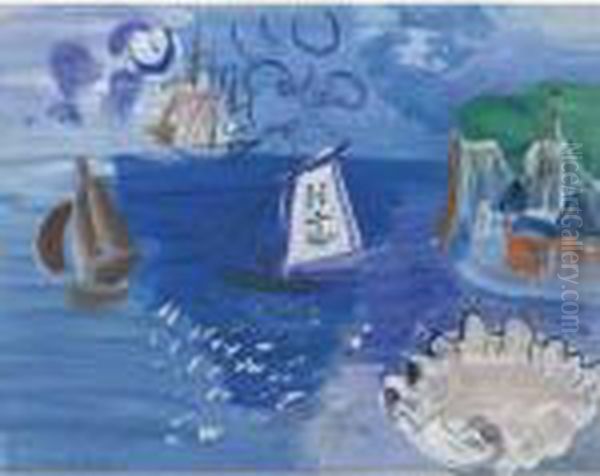
His foray into textile design led to a pivotal collaboration with the celebrated Parisian couturier Paul Poiret, starting around 1911. Dufy created vibrant, modern fabric designs for Poiret's fashion house, contributing to the era's revolution in clothing style. This success paved the way for an even longer and more prolific partnership with the prominent Lyon silk firm Bianchini-Férier, which lasted from 1912 until 1928. During this period, Dufy produced hundreds of designs for silks and other fabrics, characterized by his signature motifs – flowers, animals, shells, musical instruments – rendered in his distinctive linear style and bright colors. His work significantly impacted 20th-century textile design. Furthermore, Dufy applied his decorative sensibility to ceramics, tapestries, book illustrations (notably for Guillaume Apollinaire's Bestiaire), furniture design, and theatrical stage sets, demonstrating remarkable versatility and a commitment to bringing art into everyday life.
Monumental Achievements: La Fée Électricité
One of Raoul Dufy's most ambitious and celebrated works is the monumental mural La Fée Électricité (The Electricity Fairy). Commissioned for the Pavilion of Light and Electricity at the 1937 Paris International Exposition, this vast composition remains one of the largest paintings ever created, originally spanning over 600 square meters (approximately 6,500 square feet). The mural, painted relatively quickly using a special quick-drying medium prepared by a chemist brother-in-law, depicts the history of electricity from ancient observations to modern technological marvels.
The composition is a sprawling panorama featuring portraits of over 100 scientists, inventors, and thinkers who contributed to the understanding and application of electricity – from Aristotle and Archimedes to Benjamin Franklin, Alessandro Volta, Michael Faraday, Thomas Edison, and Albert Einstein. These figures are set against a dynamic backdrop that blends landscapes, allegorical representations, and depictions of electrical power in action, such as power stations and city lights. The work is a triumphant execution of Dufy's mature style on an epic scale, showcasing his fluid drawing, vibrant color harmonies, and his unique "color-light theory," where color itself seems to generate luminosity rather than merely depicting the effects of external light. Today, La Fée Électricité is housed in the Musée d'Art Moderne de Paris, where its scale and visual energy continue to impress visitors.
Travels and Inspirations: Capturing Light and Leisure
Travel was a constant source of inspiration throughout Raoul Dufy's career. His journeys provided him with fresh motifs and, crucially, different qualities of light that he masterfully translated into his art. The South of France held a particular allure. From the 1920s onwards, he spent considerable time on the French Riviera, particularly in Nice, as well as in Martigues and Vence. The intense Mediterranean light, the azure sea, palm trees, bustling promenades, and scenes of leisure – casinos, cafes, sailing boats – became recurrent themes in his work. These southern sojourns infused his paintings with an unparalleled brightness and sense of relaxed elegance.
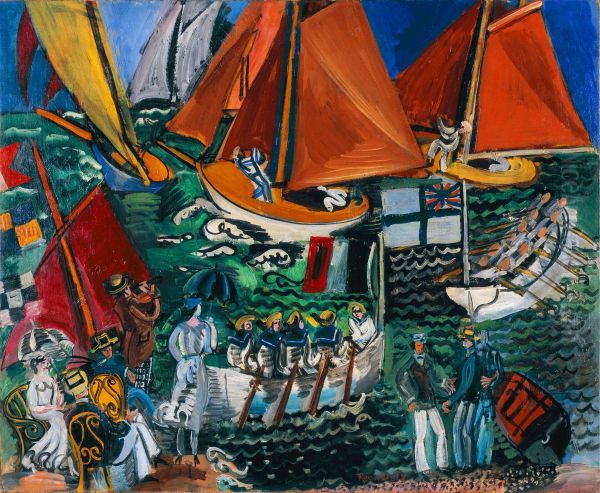
His travels were not limited to France. He visited Italy, Sicily, and made trips to England, where he captured the distinctive social atmosphere of events like the Henley Regatta and the horse races at Ascot. A journey to Morocco in North Africa also provided new visual stimuli, influencing his palette and subject matter. Even when depicting urban scenes in Paris, his hometown of Le Havre, or London, Dufy consistently sought out elements of dynamism and pleasure – parades, public festivities, the flow of river traffic. These experiences abroad continually refreshed his vision and provided the raw material for his optimistic and light-filled canvases. Late in life, seeking a different environment, he settled for a time in Boussay, in the Loire Valley.
Later Life, Resilience, and Enduring Legacy
The later years of Raoul Dufy's life were marked by health challenges. In the late 1940s, he developed severe rheumatoid arthritis, a painful condition that made painting increasingly difficult. Seeking relief and a warmer climate, he moved further south, spending time in Perpignan near the Spanish border and eventually settling in Forcalquier in Provence. Despite the debilitating effects of the illness, which sometimes required him to strap the brush to his hand, Dufy continued to work with remarkable determination and maintained the characteristic optimism and lightness in his art.
His resilience and the enduring joyfulness of his output during this period earned him admiration and contributed to his reputation as the "painter of happiness." He experimented with treatments, including early forms of cortisone therapy developed by Dr. Jonas Salk (whom he later thanked by painting his portrait). Dufy passed away from intestinal problems in Forcalquier on March 23, 1953. He was initially buried nearby but later re-interred in the Cimiez Monastery cemetery near Nice, close to his fellow artist Henri Matisse. His legacy endures through his vast body of work, which continues to charm viewers with its elegance, vibrancy, and celebration of life's pleasures.
Market Presence and Institutional Collections
Raoul Dufy's works have long been appreciated by collectors and institutions, although his market position has seen fluctuations. During his lifetime, particularly through his design work with Bianchini-Férier and his association with fashionable circles, he achieved considerable commercial success. Today, his paintings, watercolors, drawings, and prints appear regularly at major auction houses like Christie's and Sotheby's, as well as specialized galleries. Prices vary widely depending on the period, medium, size, and subject matter. Major oil paintings, especially from his Fauvist period or prime mature years, such as La baie de Sainte-Adresse (1906), can command prices well into the hundreds of thousands or even millions of dollars or euros. His watercolors and drawings, including preparatory studies for textiles like Black Roses on a Grey Background or Blue Roses Grid on a Grey Background (c. 1912), are more accessible but still highly sought after.
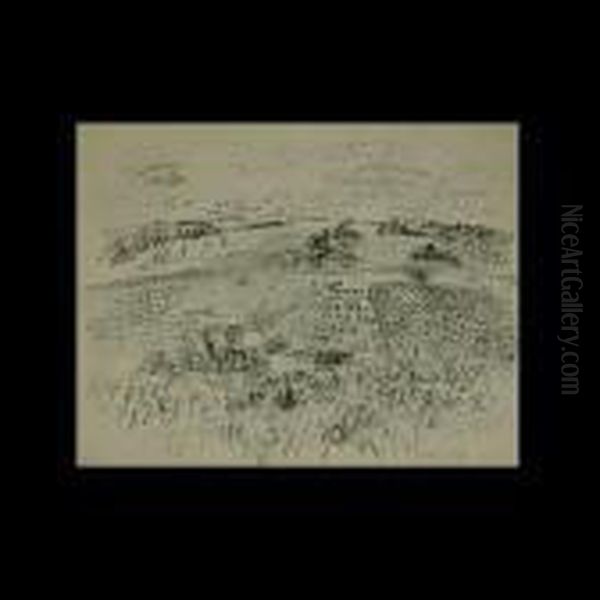
Dufy's art is well-represented in major public collections around the world. In France, the Musée d'Art Moderne de Paris (holding La Fée Électricité), the Centre Pompidou, and the Musée d'Orsay in Paris house significant works. Internationally, his paintings and designs can be found in institutions such as the Museum of Modern Art (MoMA) in New York, the Tate Modern in London, the Art Institute of Chicago, and the Museo Nazionale di Arte Moderna e Contemporanea in Rome, among many others. Numerous private collectors also hold important examples of his work, attesting to his enduring appeal across different collecting tastes.
Critical Reception and Art Historical Place
The critical reception of Raoul Dufy's work has been somewhat complex. He is undeniably recognized as a significant figure within Fauvism and an important contributor to early 20th-century modernism. His mastery of color and line is widely acknowledged, as is the infectious joy and elegance that permeate his art. His contributions to decorative arts, particularly textile design, are highly regarded and seen as influential in bridging the gap between fine art and applied arts. His technical innovations, including his unique separation of line and color and his woodcut techniques, are also noted.
However, Dufy has sometimes faced criticism for perceived superficiality. The very qualities that make his work so appealing – its lightness, charm, and decorative harmony – have occasionally led critics to dismiss it as lacking the intellectual depth or social critique found in the work of some of his contemporaries, like Picasso or the German Expressionists. His consistent focus on pleasant subjects and sophisticated leisure has sometimes been labeled as merely "fashionable" or escapist. Furthermore, his prolific output across diverse media, while demonstrating versatility, has perhaps diffused his identity as a "major" painter in the traditional sense for some historians. His style, often described as having a "deceptive simplicity," can mask the underlying skill and sophisticated compositional sense. Despite these nuances in critical appraisal, Dufy occupies a unique and enduring place in art history as a master of color, a celebrator of modern life, and an artist whose work continues to bring visual pleasure to audiences worldwide.
Conclusion: The Enduring Appeal of Dufy's Vision
Raoul Dufy remains a beloved figure in modern art, an artist whose work radiates an infectious sense of optimism and visual delight. From his early explorations of Impressionism through his vital contributions to Fauvism and his unique synthesis of modern stylistic elements, he forged a path defined by vibrant color, fluid linearity, and decorative grace. His ability to capture the fleeting pleasures of modern life – the energy of a regatta, the elegance of a concert, the sun-drenched beauty of the Mediterranean – is unparalleled. Beyond his celebrated paintings and watercolors, his innovative work in textile design and other decorative arts left a lasting mark on 20th-century aesthetics. Though sometimes viewed through the lens of charm and decoration, Dufy's art possesses a sophisticated understanding of form, color, and composition, delivered with a seemingly effortless touch. He remains the consummate "painter of happiness," whose vision continues to enchant and inspire.